1.3.1. Single Standard Calibration by Programmable Flow Injection
“Once you have exhausted all possibilities and failed, there will be one solution, simple and obvious, highly visible to anyone else.”
Flow based analyzers must be frequently calibrated, because their response to analyte concentration varies, due to changing flowrates and reagent composition. Calibration is performed by analyzing samples prepared by pipetting decreasing volumes of stock standard solution into a fixed volume, with a diluent. However, preparation of series of standard solutions and their analysis is laborious and prone to error, and therefore it is desirable to automate this process. While for serial assays, calibration is usually performed twice/day, in research setting it is performed far more frequently, because development and optimization of reagent-based assays is guided by a comparison of numerous calibration lines (1.3.4.)
Idea of auto diluting a single, most concentrated standard solution at the start of an assay cycle is trivial, but its execution is an elusive undertaking because continuous flow format is not suitable for metering variable discrete volumes and flow rates generated by peristaltic pumps are pulsatile and decrease in time. Programmable Flow Injection, on the other hand, is based on reproducible metering of variable volumes and the pump –milliGAT– can deliver volumes with reproducibility of +/- 0.5 % over a one-year period.
Principle of SSC is explained and documented here by assay of nitrite, performed on lab-on-valve platform (A) with miniSIA instrument equipped with 20cm long flow cell (B) for spectrophotometric monitoring at 520nm.
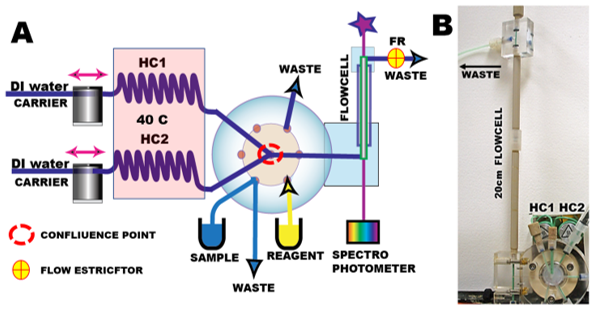
The flow protocol (C) comprises three steps where the dispended volume by pump P2 is the variable controlling concentration of standard solutions.
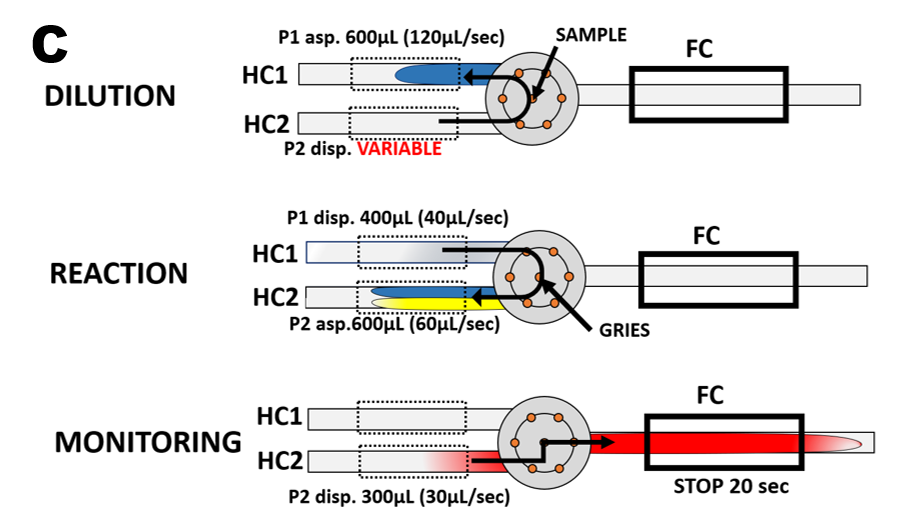 Gries Reagent #1 96 mL DI water, #2 add 4.0mL conc H2SO4 #3 add 1g sulphanilamide #4 add 25 mg n-(1-Naphtyl)ethylenamine dihydrochloride made up to 100mL with DI water.
Gries Reagent #1 96 mL DI water, #2 add 4.0mL conc H2SO4 #3 add 1g sulphanilamide #4 add 25 mg n-(1-Naphtyl)ethylenamine dihydrochloride made up to 100mL with DI water.
The flow protocol for dilution of Single Standard Solution (A) comprises five steps where the dispended volume by P2 is the single variable controlling concentration of series of standard solutions. The dispended volume increases from step 1 when SS is (almost) undiluted through steps 2 to 4, whereby SS is diluted to 1/2, 1/4 and 1/8 to step 5 – where BLANK value is obtained by monitoring carrier stream of deionized water (DI). Thus, the calibration range will comprise five points in micromolar range when SS=4.0 µM is used (column 2) and in nanomolar range when SS= 500 nM N is used (column 3).
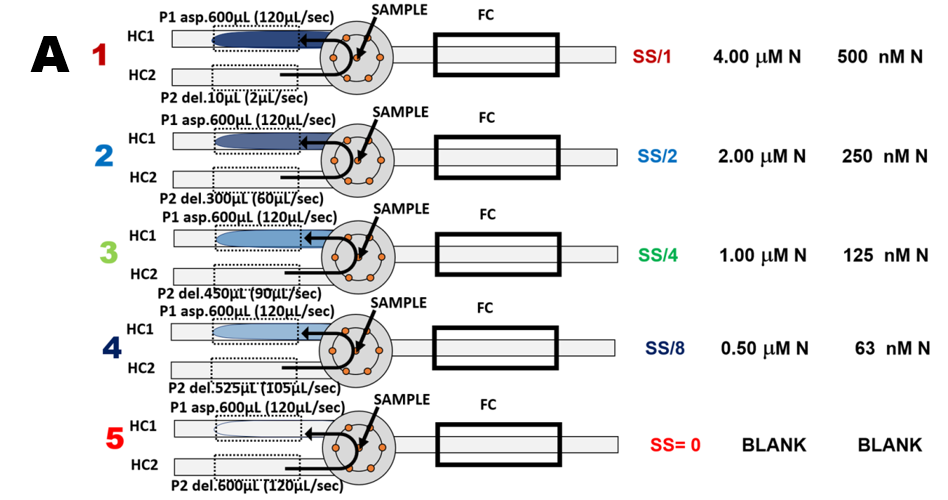
The semiautomatic protocol for assay of nitrite using SS calibration (B) generates three absorbance values for each concentration point during three cycles. The volume and flow rate for P2 as well the associated standard concentration must be typed in at the beginning of each calibration run. While semiautomatic, this approach has the advantage of the versatility of a single assay cycle that can be easier optimized than repetitive multicycle script.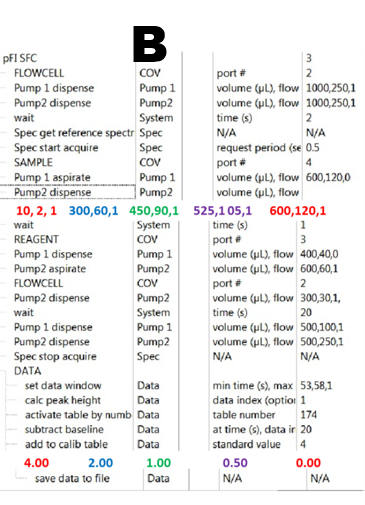 Absorbance values, collected from calibration runs (C, E), during the stop flow period (WIN), were applied to construct graphs (D, F). By using 4.0 µM N standard, the calibration line covers micromolar range by using the 500 nM N standard, calibration covers nanomolar range. Reproducibility of determination is similar in both ranges.
Absorbance values, collected from calibration runs (C, E), during the stop flow period (WIN), were applied to construct graphs (D, F). By using 4.0 µM N standard, the calibration line covers micromolar range by using the 500 nM N standard, calibration covers nanomolar range. Reproducibility of determination is similar in both ranges.
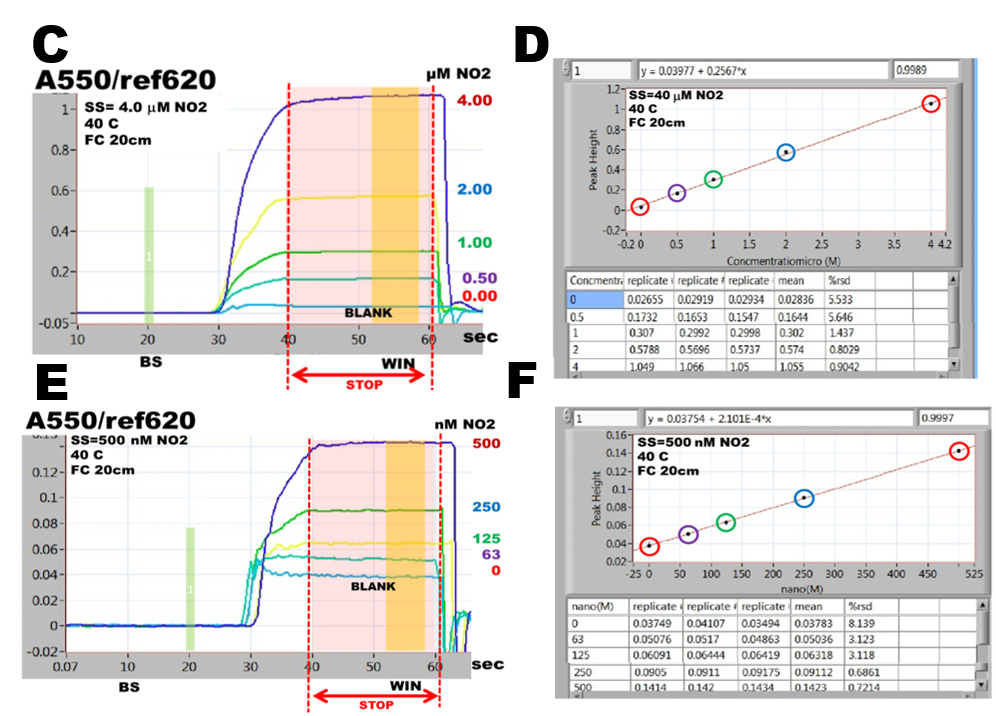
The automatic protocol is compiled by daisy chaining five identical assay protocols (A) into which increasing volumes and flowrates generated by P2, are inserted, along with corresponding standard concentrations. By programming 3 repeats in the first protocol (leaving blank in subsequent four) the chained sequence will be run sequentially in triplicate. To perform the next calibration all what is needed is to assign a new table number in all sequences. While clumsy, this way of “programming” is all I am capable of, yet everybody can use it until experts in FLOpro programming will compile more efficient script. As it is now, this design generates, for nitrite assay, a single calibration point in 100 seconds and completes, while unattended, 15-point calibration graph in 20 minutes.
.png.aspx)
Automated SSC yields flawless calibration runs (B, D) and highly reproducible calibration lines (C, E). Because the assay is designed to function in batch-flow mode, calibrations, obtained with standards prepared in DI (C) and sea water (E) are identical (F). Therefore, SS calibration yields, salinity independent calibration line suitable for determination of nutrients in sea water. (Hatta e.t. al 2021)
ACKNOWLEDGMENT. I am grateful to Christopher Measures, Mariko Hatta and Madeline Davis. To Chris for schooling me in oceanography and for critical discussions, and to Mariko and Maddie for assistance during my experimentation. J.R. April 2021.
.png.aspx)
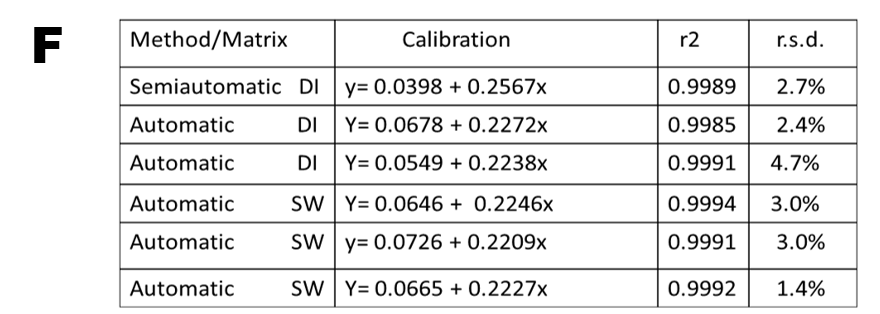
REFERENCE
M . Hatta, J. Ruzicka, Ch. I. Measures, M. Davis. "Programmable flow injection in batch mode: Determination of nutrients in sea water by using a single, salinity independent calibration line, obtained with standards prepared in distilled water.“ Talanta 232, 2021, 122354